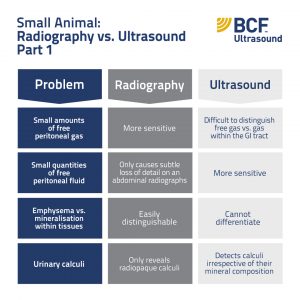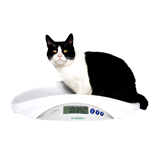Where possible, they should be used in combination to complement one another. Most vets would be aware that radiography is a great overview of organ size/shape and/or location within the abdomen whereas ultrasound is far better for assessing subtle changes and echotexture within individual organs. Here are some other examples of where ultrasound and radiography differ:
Radiology is much more sensitive at detecting small amounts of free peritoneal gas. Ultrasound detects gas, but it can be difficult to determine that the gas is free rather than contained within the GI tract. And gas on ultrasound causes dirty shadowing that may impede diagnostic visualisation of tissue distal to the gas.
Conversely, ultrasound is much more sensitive at detecting small quantities of free fluid (as little as 4.4ml per kg). Free fluid is only detectable on abdominal radiographs at volumes over twice that amount (Henley RK et al., 1989).
Ultrasound will detect small accumulations of gas or mineralisation within tissues, but the appearance can be similar (hyperechoic foci with acoustic shadowing). Radiography is easier to interpret, as mineralisation and emphysema have very different appearances. Additionally, gas within layers of tissue such as the urinary bladder wall in emphysematous cystitis, can be difficult to distinguish from gas within the bladder lumen (which may be from iatrogenic cystocentesis or catheterisation).
Ultrasound will detect urinary calculi irrespective of their mineral composition, while survey radiographs will only reveal radiopaque calculi (eg. struvite, calcium oxalate, some urates) and not radiolucent types (eg. cystine).
Ultrasound Tips regarding Cystic calculi:
To avoid mistaking polyps (sometimes concurrently present with calculi in polypoid cystitis) for calculi, remember calculi should move freely within the bladder lumen and will move to the gravity dependant portion of the bladder whereas polyps are usually attached to the cranioventral wall so won’t change position. Calculi usually (not always) cause distal acoustic shadowing whereas polyps do not.
The degree of shadowing from calculi will depend on your transducer (select appropriate MHz), image optimisation (see previous post) and the size/composition of the calculi. If they are smaller than the beam width in the X or Y plane they may not be seen so use a higher frequency and always set your focal zone to an appropriate level for the region of interest (Mattoon JS and Nyland TG., 2015).
US measurement can overestimate the size of urinary calculi by up to 50% so interpret with caution especially when planning treatment based on measurement (Byl KM et al., 2010).
You can use Colour Doppler and the twinkling artefact to identify presence of calculi which may not be detected in B mode or urinalysis (Louvet A., 2006).


























